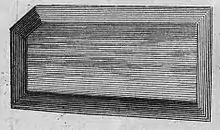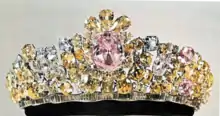Daria-i-Noor
The Daria-i-Noor (Persian: دریای نور which means “Sea of light” in Persian), also spelled Darya-ye Noor, is one of the largest cut diamonds in the world, weighing an estimated 182 carats (36 g).[1] Its colour, pale pink, is one of the rarest to be found in diamonds. The diamond is currently in the Iranian Crown Jewels collection of the Central Bank of Iran in Tehran.[2]
_Diamond_from_the_collection_of_the_national_jewels_of_Iran_at_Central_Bank_of_Islamic_Republic_of_Iran.jpg.webp) The Daria-e Noor (Sea of Light) Diamond from the collection of the national jewels of Iran at Central Bank of Islamic Republic of Iran (Tehran). | |
| Weight | 182 carats (36.4 g) |
|---|---|
| Color | Pale pink |
| Cut | Tabular, free-form. Inscribed. |
| Country of origin | India |
| Mine of origin | Kollur Mine |
| Owner | Central Bank of Iran, Tehran, Iran |
Dimensions
It is 41.40 x 29.50 x 12.15 mm and weighing around 182 metric carats, the world's largest known pink diamond.[1]
History
This diamond, like the Koh-i-Noor, was mined in Vijayawada, India.[3] It was originally owned by the Kakatiya dynasty, later it was possessed by the Khalji dynasty of the Delhi Sultanate and to Mughal emperors. It was part of Shah Jahan's Peacock Throne.
In 1739, Nader Shah of Iran invaded Northern India, occupied Delhi. As payment for returning the crown of India to the Mughal emperor, Muhammad, he took possession of the entire fabled treasury of the Mughals, including the Daria-i-Noor, in addition to the Koh-i-Noor and the Peacock Throne.[1]
After Nader Shah's death in 1747, the diamond was inherited by his grandson, Sharukh Mirza. From there, it fell into the hands of the Lotf Ali Khan. After Lotf Ali Khan's defeat at the hands of Mohammad Khan Qajar, who established the ruling Qajar dynasty of Iran, the Daria-i-Noor entered the Qajar treasury. During this time, Naser al-Din Shah Qajar was said to be very fond of the diamond, often wearing it as an armband, aigrette, or a brooch and maintenance of the diamond was an honor bestowed upon higher ranking individuals.[2]
Possible association


In 1965, a Canadian team conducting research on the Iranian Crown Jewels concluded that the Daria-i-Noor may well have been part of a large pink diamond that had been studded in the throne of the Mughal emperor Shah Jahan, and had been described in the journal of the French jeweller Jean-Baptiste Tavernier in 1642, who called it the Great Table diamond ("Diamanta Grande Table"). This diamond may have been cut into two pieces; the larger part is the Daria-i-Noor; the smaller part is believed to be the 60-carat (12 g) Noor-ul-Ain diamond, presently studded in a tiara also in the Iranian Imperial collection.[4]
See also
References
- Malecka, Anna (2017). "Daryā-ye Nur: History and Myth of a Crown Jewel of Iran". Iranian Studies. 51 (1): 69–96. doi:10.1080/00210862.2017.1362952.
- "Collections". cbi.ir. Archived from the original on 26 February 2014. Retrieved 1 March 2014.
- Satyanarayana, S. V. (2000). "Diamonds in the Deccan: An Overview". In Gupta, Harsh K.; Parasher, A.; Balasubramanian, D. (eds.). Deccan Heritage. INSA and Universities Press (India). p. 144. ISBN 978-81-7371-285-2.
- https://www.britannica.com/topic/Darya-e-Nur#ref92943